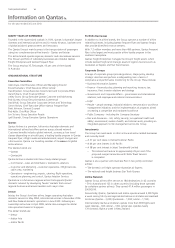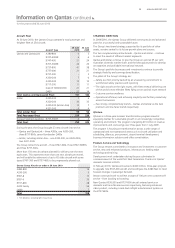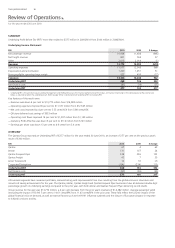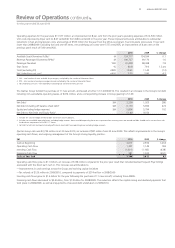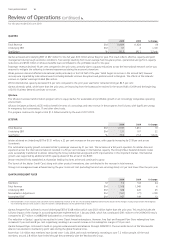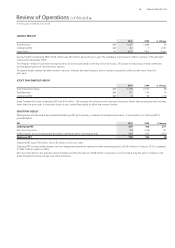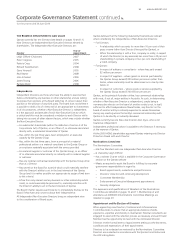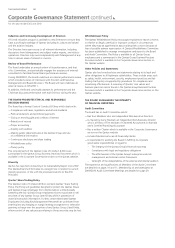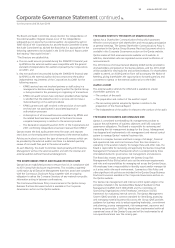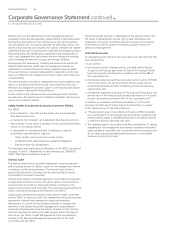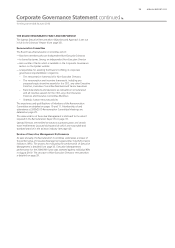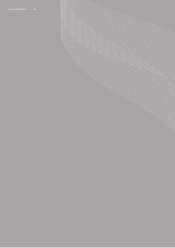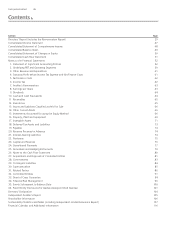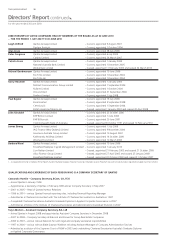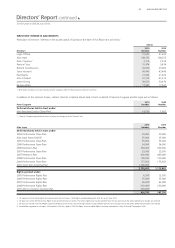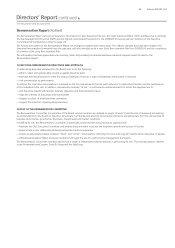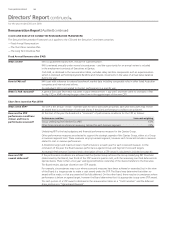Qantas 2010 Annual Report Download - page 26
Download and view the complete annual report
Please find page 26 of the 2010 Qantas annual report below. You can navigate through the pages in the report by either clicking on the pages listed below, or by using the keyword search tool below to find specific information within the annual report.
THE QANTAS GROUP 24
for the year ended 30 June 2010
Material risks and the effectiveness of risk management plans are
escalated to Executive Management, relevant Board Committees and/or
the Board as appropriate and are reported on as part of the quarterly
risk reporting process. During the quarterly risk reporting process, each
Qantas Group business unit prepares and submits a detailed risk register
outlining the key risks to achieving their objectives and mitigating actions.
Beyond reporting, the identi cation, assessment and management of
risks is also integrated into key business decision-making and activities,
such as strategy development, projects and change initiatives.
Management self-assessments, including self-assessments against the
different QMS elements, audits and risk management reviews are
undertaken to con rm that risks are being mitigated where possible.
On a quarterly basis, Executive Management is required to certify that
there is an effective risk management process in place within their area
of responsibility.
The internal auditor, through an independent third party validation, also
reports to the Board and relevant Board Committees that there is an
effective risk management process in place for the nancial period and
up to the date of signing the Financial Report.
Further details of the Framework and corporate governance structure
are captured in the Qantas Investor Data Book available in the Investors
section on the Qantas website.
Safety, Health, Environment & Security Committee (SHESC)
The SHESC:
—Has six Members – the CEO and ve others who are Independent
Non-Executive Directors
—Is chaired by John Schubert, an Independent Non-Executive Director
—Has a written Charter which is available in the Corporate Governance
section on the Qantas website
—Is responsible for assisting the Board in ful lling its corporate
governance responsibilities in regard to:
– Safety, health, environment and security matters
– Compliance with related legal and regulatory obligations
– Enterprise-wide risk management
The experience and quali cations of Members of the SHESC are detailed
on pages 10 and 11. Membership of and attendance at 2009/2010
SHESC Meetings are detailed on page 29.
Internal Audit
The Internal Audit function provides independent, objective assurance
and consulting services on Qantas’ system of risk management, internal
compliance, control and governance. The Internal Audit charter is
approved by the Audit Committee and the Internal Auditor reports
functionally to the Audit Committee.
Internal Audit adopts a risk-based approach in formulating its audit plan
to align audit activities to the key risks across Qantas. The audit plan is
reviewed every six months to align audit activity to changes to the
Qantas Group business and risk pro le. The audit plan is approved by the
Audit Committee bi-annually and endorsed by the SHESC.
Audit projects performed by Internal Audit assist the Audit Committee
and the SHESC to promote sound risk management and good corporate
governance. Internal Audit assesses the design and operating
effectiveness of controls for key business processes to mitigate risks
identi ed in the Qantas risk pro le. Management is responsible for
ensuring that appropriate corrective actions are taken on the reported
areas for improvement arising from audit projects within the required
time frame. The status of audit Management actions are submitted
monthly to the Executive Management and quarterly to the Audit
Committee and the SHESC.
The Internal Audit function is independent of the external auditor, has
full access to Management and the right to seek information and
explanation. The Audit Committee oversees the scope of the Internal
Audit function and has access to the Internal Auditor without the
presence of Management.
CEO/CFO Declaration
As required by section 295A of the Corporations Act, the CEO and CFO
have declared that:
“In our opinion:
a. the nancial records of Qantas and its controlled entities (Qantas
Group) for the nancial year ended 30 June 2010 (Financial Period)
have been properly maintained in accordance with section 286 of
the Corporations Act;
b. the nancial statements and the notes referred to in section 295(3)(b)
of the Corporations Act for the Financial Period comply with the
accounting standards and other mandatory professional reporting
requirements; and
c. the nancial statements and notes for the Financial Period give a true
and fair view of the nancial position and performance of the Qantas
Group in accordance with section 297 of the Corporations Act.”
In addition, in accordance with Recommendation 7.3 of the ASX
Principles, the CEO and CFO also state to the Board that, in respect
of the Qantas Group for the Financial Period:
a. “The declaration given in accordance with section 295A is founded
on a sound system of risk management and internal compliance and
control and the system is operating effectively in all material respects
in relation to nancial reporting risks; and
b. The statement given in accordance with Recommendation 7.3 (above)
regarding the risk management and internal compliance and control
system provide a reasonable, but not absolute level of assurance and
do not imply a guarantee against adverse events or more volatile
outcomes arising in the future.”
Corporate Governance Statement continued


